Experimental Wear Analysis of Nano-Sized Titania Particles as Additives in Automotive Lubricants
Abstract
:1. Introduction
2. Literature Review
3. Materials and Methods
4. Results
5. Discussion and Conclusions
- Based on the tribological results, the application of the titanium dioxide nanoparticles increases the friction by 20 to 32%. The consensus of the literature is that nano-sized titania particles have a friction-reducing effect, whereas the tests in this article report an increase in friction. While titania nanoparticles have been found to increase the viscosity of lubricating oil, titania was not able to prevent the massive friction-increasing effect of adhesion. In the future, it would be advisable to repeat the tests on the nanoparticles using some surface functionalization techniques on the nanoparticles.
- Titania nanoparticles could reduce the size of wear diameters by up to 32%. Titania protected the surface from forming deep grooves and reduced the wear volume parameters even up to 57%. These obtained results fully meet the expectations based on the literature.
- Titania increases the repeatability of the measurements, as the standard deviation of the measured values is significantly lower in every aspect. Publications have reported on the strengthening of the ability of nanoparticles to stabilize the tribological system.
- The optimum titania concentration in the used tribosystem can be defined at 0.4 wt%. The optimal concentration of the nano-additive in each tribological system used is different. The obtained result corresponds in magnitude with the optimum concentrations found in the literature.
- Scanning electron microscopy revealed that the primary wear type on the worn surface is abrasive wear. Abrasive wear is the main natural wear type characteristic of most tribological systems. Adhesive wear was found on the whole wear track, but it occurs more in the middle point of the wear track (highest relative speed area).
- Titanium intensity images revealed that all the worn area contains titania, but most of them can be found in the bottom of the deep wear grooves. EDX quantification defined the amount of titanium content on the worn surface as 0.56 to 0.62%. A result consistent with the literature is that the titania-rich tribofilm increases wear resistance.
Author Contributions
Funding
Data Availability Statement
Acknowledgments
Conflicts of Interest
References
- Krishna, C.; Ankit, K.; Venkatasubramaniam, L.; Ammar, H.; Elsheikh, M.K.A.A. A review of the tribological and thermophysical mechanisms of bio-lubricants based nanomaterials in automotive applications. J. Mol. Liq. 2021, 339, 116717. [Google Scholar] [CrossRef]
- Rajaganapathy, C.; Vasudevan, D.; Murugapoopathi, S. Tribological and rheological properties of palm and brassica oil with inclusion of CuO and TiO2 additives. Mater. Today Proc. 2021, 37, 207–213. [Google Scholar] [CrossRef]
- Mohamed, K.A.A.; Mohamed, A.A.A.; Ahmed, E.; Essa, F.A.; Hou, X. Mini-Review on the Significance Nano-Lubricants in Boundary Lubrication Regime. Int. J. Biosens. Bioelectron. 2017, 2, 42–43. [Google Scholar] [CrossRef]
- Ling, Z.; Lei, C.; Hongqi, W.; Jianmin, C.; Huidi, Z. Synthesis and Tribological Properties of Stearic Acid-Modified Anatase (TiO2) Nanoparticles. Tribol. Lett. 2011, 41, 409–416. [Google Scholar] [CrossRef]
- Wenyu, Y.; Tiefeng, C.; Qing, Y.; Xinyong, G.; Zhijun, Z.; Hongxin, D. Preparation and tribological properties of tetrafluorobenzoic acid-modified TiO2 nanoparticles as lubricant additives. Mater. Sci. Eng. A 2003, 359, 82–85. [Google Scholar] [CrossRef]
- Gu, K.; Chen, B.; Chen, Y. Preparation and tribological properties of lanthanum-doped TiO2 nanoparticles in rapeseed oil. J. Rare Earths 2013, 31, 589–594. [Google Scholar] [CrossRef]
- Harshvardhan, H.P.; Girish, B.P.; Pritam, V.M.; Yuvraj, P.B.; Vivek, S.G. Enhancement of tribological properties by adding titanium dioxide (TiO2) nanoparticles in mineral based SN-500 oil. Mater. Today Proc. 2022, 59, 128–133. [Google Scholar] [CrossRef]
- Peña-Parás, L.; Taha-Tijerina, J.; García, A.; Maldonado, D.; Nájera, A.; Cantú, P.; Ortiz, D. Thermal transport and tribological properties of nanogreases for metal-mechanic applications. Wear 2015, 332–333, 1322–1326. [Google Scholar] [CrossRef]
- Mathivanan, E.; Gasior, D.; Liu, L.; Yee, K. Experimental Investigation of the Impact of Nanofluids on Heat Transfer Performance of a Motorcycle Radiator; SAE Technical Paper 2017-01-1611; SAE International: Warrendale, PA, USA, 2017. [Google Scholar] [CrossRef]
- Jung, S.; Jo, B.; Shin, D.; Banerjee, D. Experimental Validation of a Simple Analytical Model for Specific Heat Capacity of Aqueous Nanofluids; SAE Technical Paper 2010-01-1731; SAE International: Warrendale, PA, USA, 2010. [Google Scholar] [CrossRef]
- Ilie, F.; Covaliu, C. Tribological Properties of the Lubricant Containing Titanium Dioxide Nanoparticles as an Additive. Lubricants 2016, 4, 12. [Google Scholar] [CrossRef]
- Sudeep, I.; Archana, C.; Amol, K.; Umare, S.S.; Bhatt, D.V.; Jyoti, M. Tribological behavior of nano TiO2 as an additive in a base oil. Wear 2013, 301, 776–785. [Google Scholar] [CrossRef]
- Ilie, F.; Ipate, G.; Manaila, F.C. Tribological Properties Study of Solid Lubrication with TiO2 Powder Particles. Materials 2022, 15, 7145. [Google Scholar] [CrossRef]
- Hui, W.; Jingwei, Z.; Wenzhen, X.; Xiawei, C.; Anshun, H.; Jung, H.Y.; Lianzhou, W.; Han, H.; Sihai, J.; Li, H.; et al. A study of the tribological behavior of TiO2 nano-additive water-based lubricants. Tribol. Int. 2017, 109, 398–408. [Google Scholar] [CrossRef]
- Wu, Y.Y.; Tsui, W.C.; Liu, T.C. Experimental analysis of tribological properties of lubricating oils with nanoparticle additives. Wear 2007, 262, 819–825. [Google Scholar] [CrossRef]
- Rani, S. The tribological behavior of TiO2, CeO2, and ZrO2 nanoparticles as a lubricant additive in rice bran oil. Int. J. Sci. Eng. Res. 2016, 7, 708–712. [Google Scholar]
- Li, J.; Xu, X.; Zhang, L.; Zhang, J. Tribological Synergism of Surface TiO2 Nanoparticles and Sulfurized Olefin; SAE Technical Paper 2008-01-1618; SAE International: Warrendale, PA, USA, 2008. [Google Scholar] [CrossRef]
- Hamisa, A.H.; Azmi, W.H.; Ismail, M.F.; Rahim, R.A.; Ali, H.M. Tribology Performance of Polyol-Ester Based TiO2, SiO2, and Their Hybrid Nanolubricants. Lubricants 2023, 11, 18. [Google Scholar] [CrossRef]
- Ismail, M.F.; Azmi, W.H.; Mamat, R.; Ali, H.M. Thermal and Tribological Properties Enhancement of PVE Lubricant Modified with SiO2 and TiO2 Nanoparticles Additive. Nanomaterials 2023, 13, 42. [Google Scholar] [CrossRef]
- Jiguo, C. Tribological Properties of Polytetrafluoroethylene, Nano-Titanium Dioxide, and Nano-Silicon Dioxide as Additives in Mixed Oil-Based Titanium Complex Grease. Tribol. Lett. 2010, 38, 217–224. [Google Scholar] [CrossRef]
- Kuo, Y.; Xin, F.; Yanqiu, X. A synergetic strategy based on texture and Nano-TiO2 grease to improve the tribological and insulating properties of the matrix under current-carrying friction. Tribol. Int. 2023, 183, 108379. [Google Scholar] [CrossRef]
- Sheida, S.; Samira, B.; Sharifah, B.A.H. Enhancing lubricant properties by nanoparticle additives. Int. J. Hydrogen Energy 2016, 41, 3153–3170. [Google Scholar] [CrossRef]
- Mu-Jung, K.; Chil-Ruey, L. Evaluating the role of spherical titanium oxide nanoparticles in reducing friction between two pieces of cast iron. J. Alloys Compd. 2009, 483, 456–459. [Google Scholar] [CrossRef]
- Mohamed, K.A.A.; Hou, X. Improving the tribological behavior of internal combustion engines via the addition of nanoparticles to engine oils. Nanotechnol. Rev. 2015, 4, 347–358. [Google Scholar] [CrossRef]
- Yongjian, G.; Guoxu, C.; Ya, O.; Zhijun, Z.; Qunji, X. Study on tribological properties of oleic acid-modified TiO2 nanoparticle in water. Wear 2002, 252, 454–458. [Google Scholar] [CrossRef]
- Bogunovic, L.; Zuenkeler, S.; Toensing, K.; Anselmetti, D. An Oil-Based Lubrication System Based on Nanoparticular TiO2 with Superior Friction and Wear Properties. Tribol. Lett. 2015, 59, 29. [Google Scholar] [CrossRef]
- Sharma, V.; Timmons, R.B.; Erdemir, A.; Aswath, P.B. Interaction of plasma functionalized TiO2 nanoparticles and ZDDP on friction and wear under boundary lubrication. Appl. Surf. Sci. 2019, 489, 372–383. [Google Scholar] [CrossRef]
- Gu, C.; Zhu, G.; Li, L.; Tian, X.; Zhu, G. Tribological effects of oxide-based nanoparticles in lubricating oils. J. Mar. Sci. Appl. 2009, 8, 71–76. [Google Scholar] [CrossRef]
- Jyoti, P.S.; Shiva, S.; Tandra, N.; Subrata, K.G. Development of graphitic lubricant nanoparticles based nanolubricant for automotive applications: Thermophysical and tribological properties followed by IC engine performance. Powder Technol. 2021, 387, 31–47. [Google Scholar] [CrossRef]
- Ali, M.K.A.; Xianjun, H.; Elagouz, A.; Essa, F.A.; Abdelkareem, M.A.A. Minimizing of the boundary friction coefficient in automotive engines using Al2O3 and TiO2 nanoparticles. J. Nanopart. Res. 2016, 18, 377. [Google Scholar] [CrossRef]
- Binu, K.G.; Shenoy, B.S.; Rao, D.S.; Pai, R. A variable Viscosity Approach for the Evaluation of load Carrying Capacity of oil-lubricated Journal Bearing with TiO2 Nanoparticles as Lubricant Additives. Procedia Mater. Sci. 2014, 6, 1051–1067. [Google Scholar] [CrossRef]
- Mubashar, A.; Azad, H.; Ali, H.; Hanen, K.; Piotr, W.; Ilyas, K.; Mulugeta, A.; Ahmed, M.G. Scrutinization of Slip Due to Lateral Velocity on the Dynamics of Engine Oil Conveying Cupric and Alumina Nanoparticles Subject to Coriolis Force. Math. Probl. Eng. 2022, 2022, 2526951. [Google Scholar] [CrossRef]
- Pan, D.; Zhang, G.; Jia, F.; Li, L.; Zhang, T.; Lu, Y.; Wu, H.; Yang, M.; Jiang, Z. Analysis of TiO2 Nanolubricant Influence in Micro Deep Drawing of Stainless Steel SUS301. Materials 2023, 16, 2196. [Google Scholar] [CrossRef]
- Zulkifli, N.W.M.; Kalam, M.A.; Masjuki, H.H.; Yunus, R. Experimental analysis of tribological properties of bio lubricant with nanoparticle additive. Procedia Eng. 2013, 68, 152–157. [Google Scholar] [CrossRef]
- Meena, L.; Vijay, K.S.J. Titanium oxide nanoparticles as additives in engine oil. J. King Saud Univ. Eng. Sci. 2018, 30, 116–122. [Google Scholar] [CrossRef]
- Said, L.B.; Kolsi, L.; Ghachem, K.; Almeshaal, M.; Maatki, C. Application of nanofluids as cutting fluids in machining operations: A brief review. Appl. Nanosci. 2022, 12, 4214. [Google Scholar] [CrossRef]
- Hanaor, D.A.H.; Sorrell, C.C. Review of the anatase to rutile phase transformation. J. Mater. Sci. 2011, 46, 855–874. [Google Scholar] [CrossRef]
- Lee, E.O.; Min-Yee, C.; Hwei, V.L.; Hwai, C.O.; Sharifah, B.A.H.; Joon, C.J. Recent advances of titanium dioxide (TiO2) for green organic synthesis. RSC Adv. 2016, 6, 108741–108754. [Google Scholar]
- Borgese, L.; Gelfi, M.; Bontempi, E.; Goudeau, P.; Geandier, G.; Thiaudière, D.; Depero, L.E. Young modulus and Poisson ratio measurements of TiO2 thin films deposited with Atomic Layer Deposition. Surf. Coat. Technol. 2012, 206, 2459–2463. [Google Scholar] [CrossRef]
- Patzer, G.; Woydt, M. New Methodologies Indicating Adhesive Wear in Load Step Tests on the Translatory Oscillation Tribometer. Lubricants 2021, 9, 101. [Google Scholar] [CrossRef]
- ISO 19291:2016(E); Lubricants—Determination of Tribological Quantities for Oils and Greases—Tribological Test in the Translator Oscillation Apparatus. International Organization for Standardization: Geneva, Switzerland, 2016; Volume 1, pp. 1–13.
- Tóth, Á.D.; Paulovics, L.; Hanula, B.; Kopp, A.; Knaup, J. Development of testing methodology for tribological characterization of different engine lubricants. In Proceedings of the Reibung, Schmierung und Verschleiß—Forschung und Praktische Anwendung, Göttingen, Germany, 25–27 September 2017; Gesellschaft für Tribologie e.V.: Aachen, Germany, 2017. [Google Scholar]

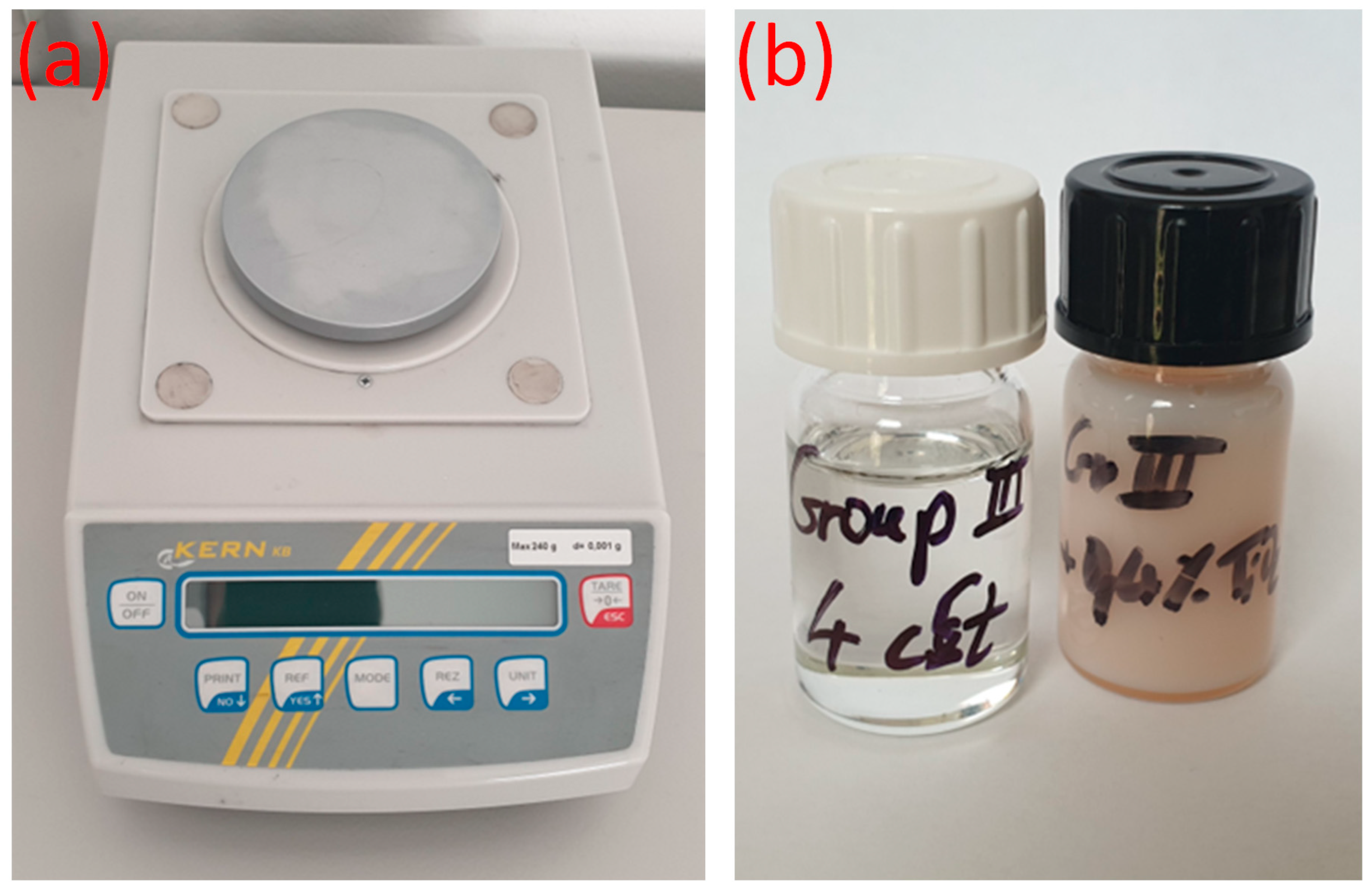
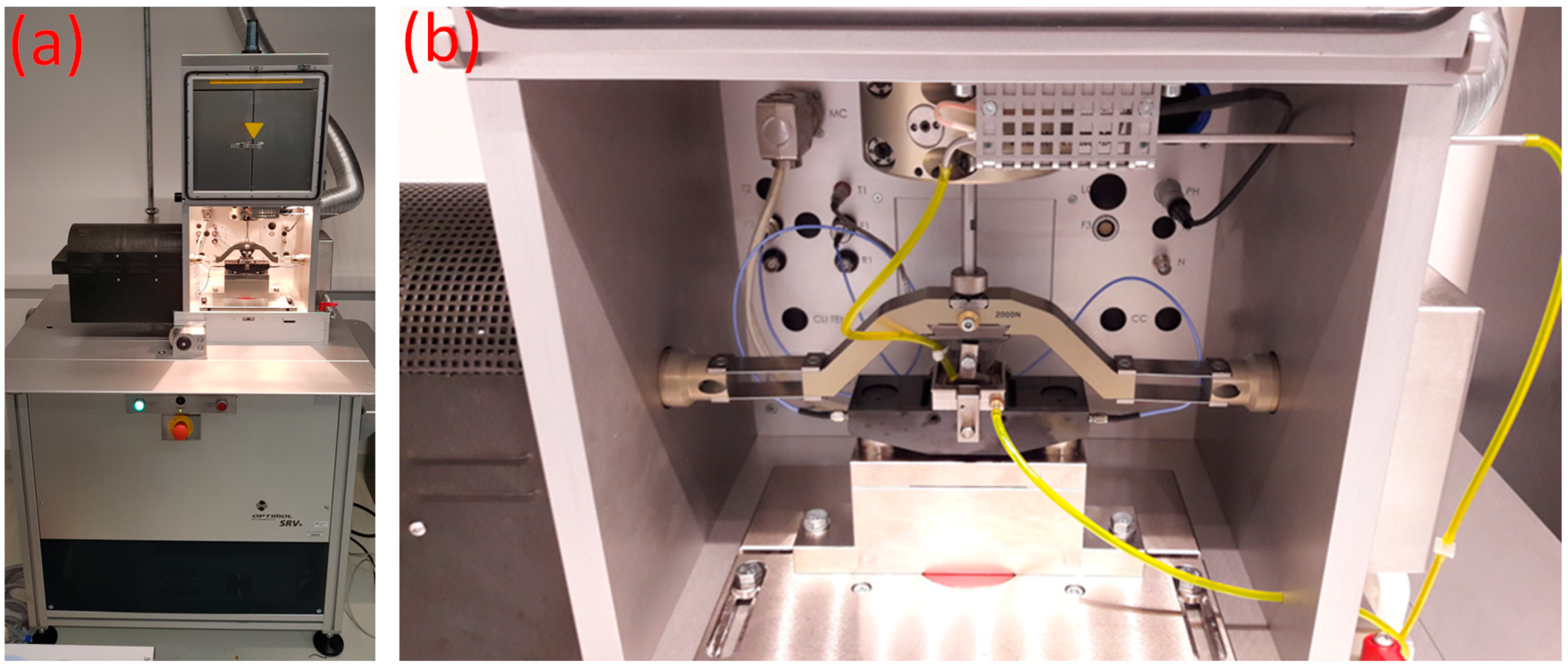
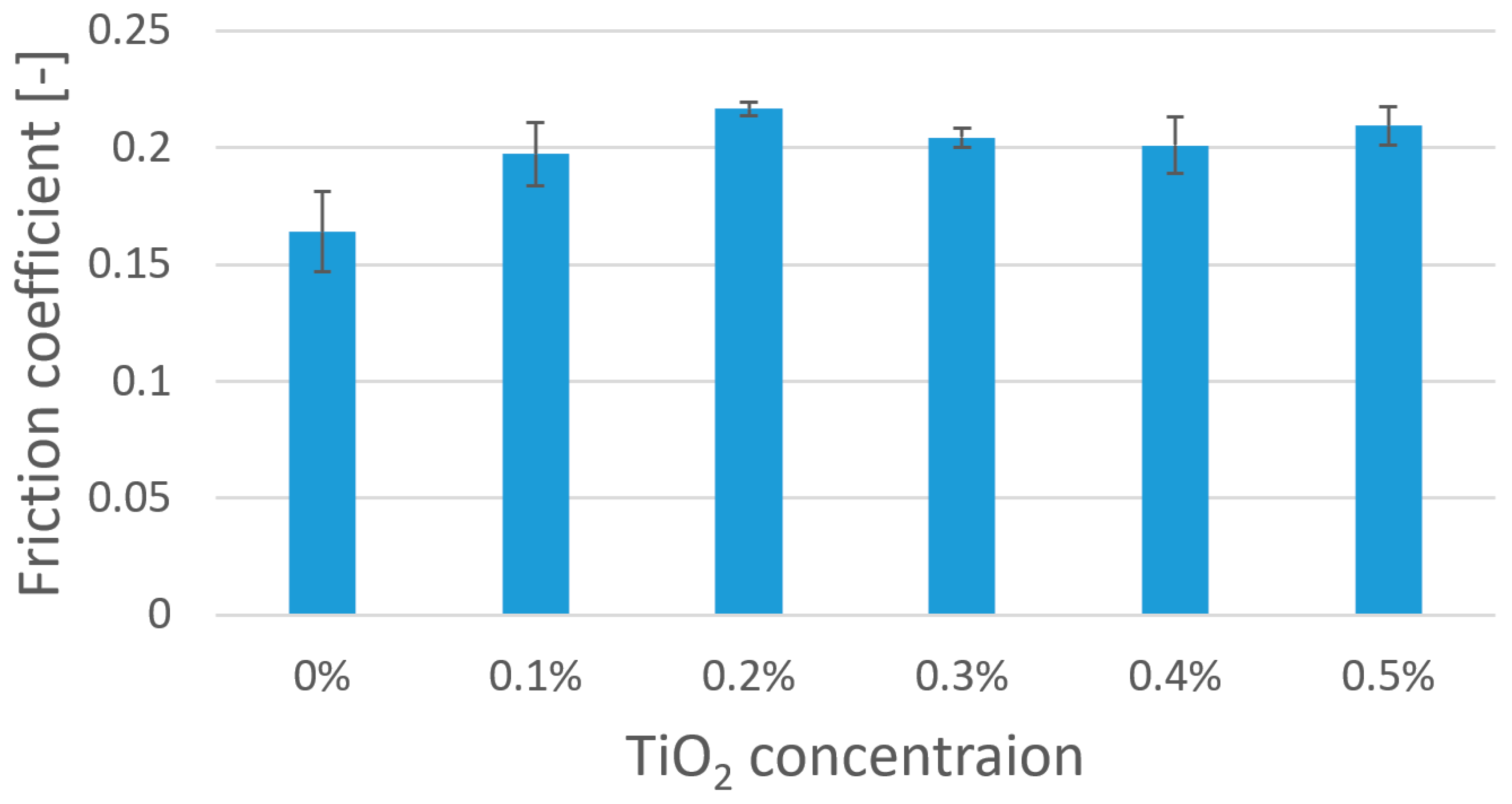
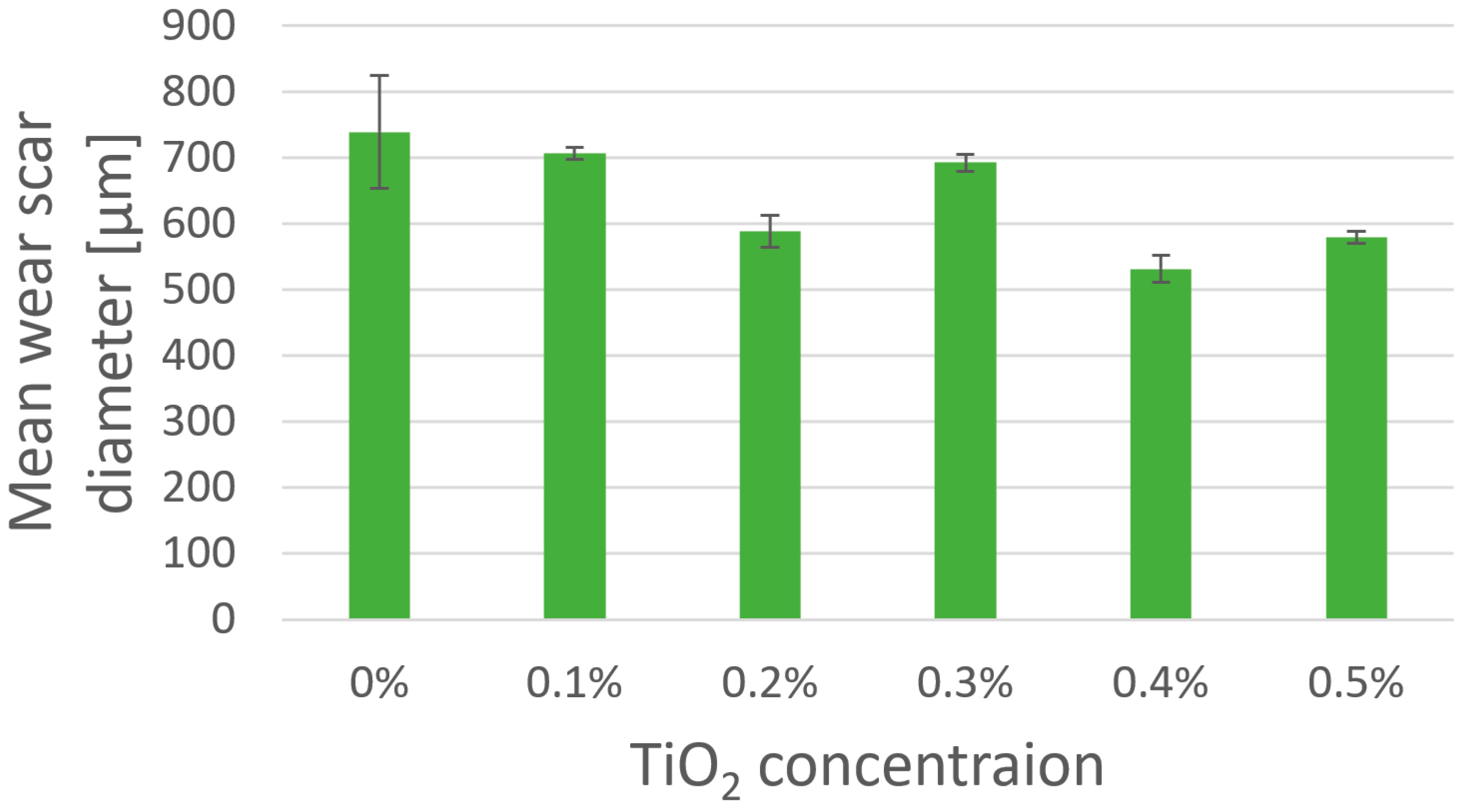

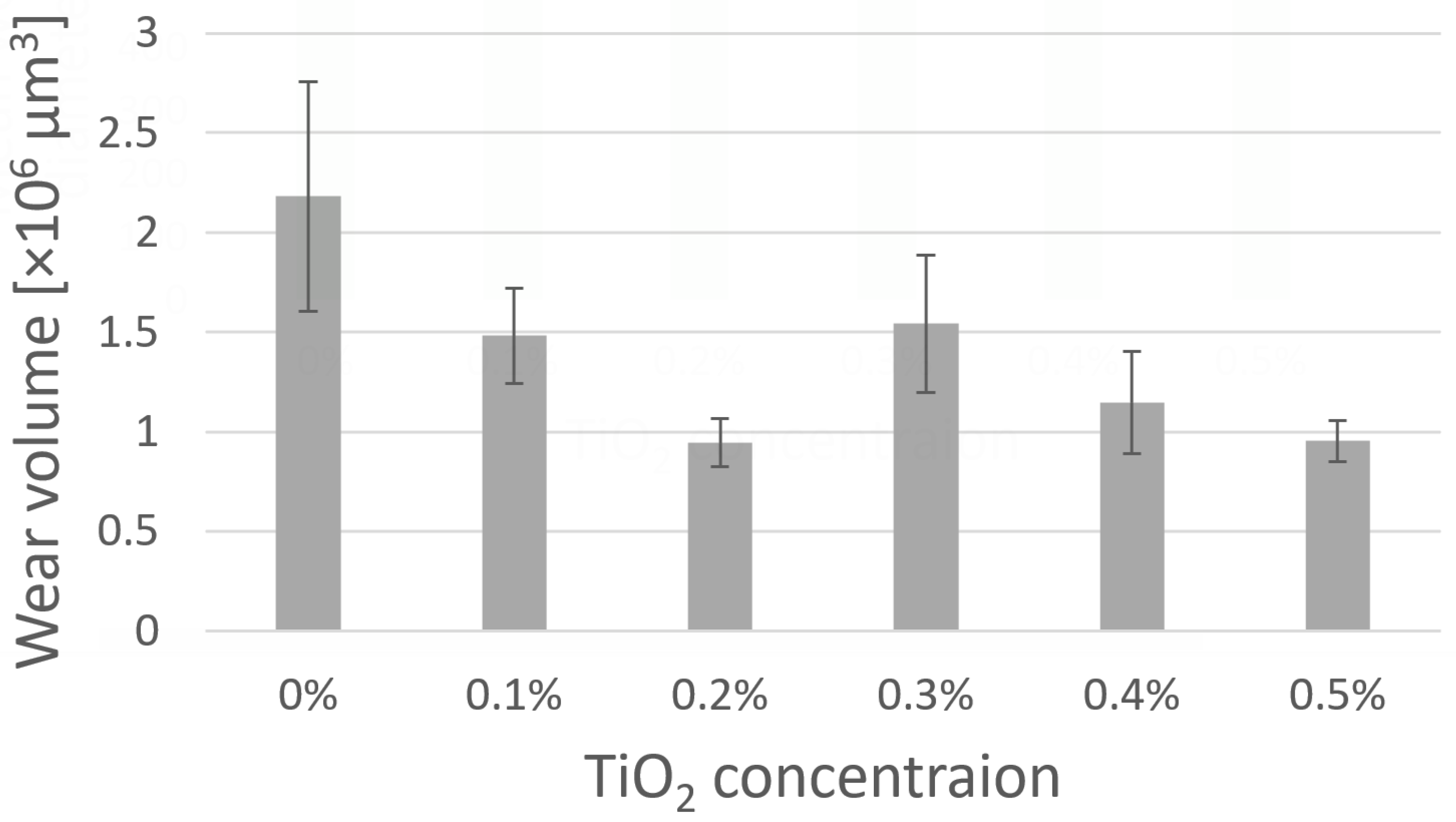
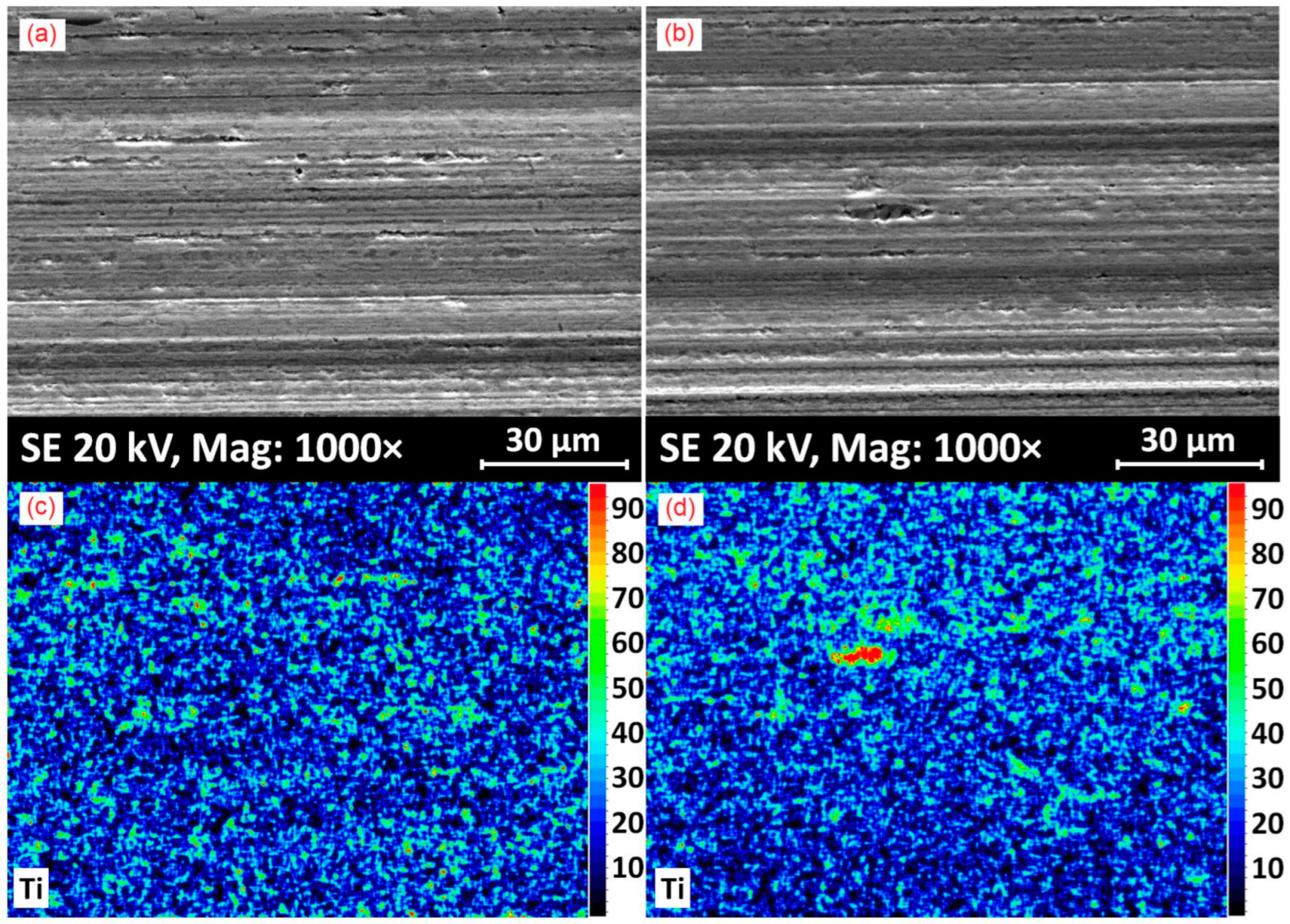

| Parameter on 100 °C | Group III | Group III + 0.4% TiO2 | Change [%] |
|---|---|---|---|
| Dynamic viscosity [mPa·s] | 3.432 | 3.663 | +6.73% |
| Kinematic viscosity [mm2/s] | 4.373 | 4.653 | +6.39% |
| Density [g/cm3] | 0.7848 | 0.7873 | +0.32% |
| Element | Reference Surface | Center of the Wear Track | Dead Center of the Wear Track |
|---|---|---|---|
| Iron | 88.73 | 91.72 | 73.21 |
| Chromium | 1.49 | 1.38 | 0.84 |
| Silicon | 0.75 | 1.39 | 1.04 |
| Oxygen | 2.33 | 3.7 | 2.25 |
| Carbon | 6.70 | 1.19 | 22.1 |
| Titanium | 0 | 0.62 | 0.56 |
Disclaimer/Publisher’s Note: The statements, opinions and data contained in all publications are solely those of the individual author(s) and contributor(s) and not of MDPI and/or the editor(s). MDPI and/or the editor(s) disclaim responsibility for any injury to people or property resulting from any ideas, methods, instructions or products referred to in the content. |
© 2023 by the authors. Licensee MDPI, Basel, Switzerland. This article is an open access article distributed under the terms and conditions of the Creative Commons Attribution (CC BY) license (https://creativecommons.org/licenses/by/4.0/).
Share and Cite
Szabó, Á.I.; Tóth, Á.D.; Abdallah, H.; Hargitai, H. Experimental Wear Analysis of Nano-Sized Titania Particles as Additives in Automotive Lubricants. Micro 2023, 3, 715-727. https://doi.org/10.3390/micro3030050
Szabó ÁI, Tóth ÁD, Abdallah H, Hargitai H. Experimental Wear Analysis of Nano-Sized Titania Particles as Additives in Automotive Lubricants. Micro. 2023; 3(3):715-727. https://doi.org/10.3390/micro3030050
Chicago/Turabian StyleSzabó, Ádám István, Álmos Dávid Tóth, Hebah Abdallah, and Hajnalka Hargitai. 2023. "Experimental Wear Analysis of Nano-Sized Titania Particles as Additives in Automotive Lubricants" Micro 3, no. 3: 715-727. https://doi.org/10.3390/micro3030050








